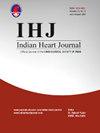左心耳功能急性改变伴早衰心室复合体。
IF 1.8
Q3 CARDIAC & CARDIOVASCULAR SYSTEMS
引用次数: 0
摘要
目的:左心耳功能障碍是脑卒中的危险因素之一。有证据表明,频繁的室性早搏(早搏)与栓塞性卒中有关。左心房功能障碍是否是频繁的室性早搏和脑卒中之间的桥梁尚不清楚。材料和方法:选取结构正常的心脏患者进行选择性电生理研究。经食管超声检测LAA血流速度。为了模拟双心室节律时的室性早搏,每次窦性搏动后以QT + 10% RR的耦合间隔从右心室传送单步搏动。在基线、起搏5分钟后和停止起搏5分钟后再次获得LAA血流多普勒速度。结果:10例患者纳入研究。与基线(68.01±10.34 cm/s)相比,舒张后期排空速度(55.68±16.33 cm/s, p = 0.01)明显降低。休息5分钟后,几乎恢复到基线水平(63.13±16.16 cm/s, p = 0.277)。左心耳充盈速度在室性早搏5 min后呈下降趋势(45.70±10.85 cm/s, p = 0.129),而基线值为51.31±14.11 cm/s。结论:双分体型早衰心室复合体持续5分钟可导致舒张后期排空速度急性降低。这可能是频发室性早搏患者卒中风险增加的机制。本文章由计算机程序翻译,如有差异,请以英文原文为准。

Acute changes in left atrial appendage function with premature ventricular complexes
Objectives
Left atrial appendage (LAA) dysfunction is a risk factor for stroke. Evidence shows that frequent premature ventricular complexes (PVCs) are associated with embolic stroke. Whether left atrial dysfunction is the bridging link between frequent premature ventricular complexes and stroke is unknown.
Materials and methods
Patients with a structurally normal heart undergoing elective electrophysiology study were included. Transoesophageal echo was used to measure LAA flow velocities. To simulate PVCs in bigeminal rhythm, single paced beats were delivered from the right ventricle with a coupling interval of QT + 10 % RR interval after each sinus beat. LAA flow doppler velocities were acquired at baseline, after 5 min of pacing and again 5 min after cessation of pacing.
Results
Ten patients were included in the study. Late diastolic emptying velocity decreased significantly after 5 min of PVCs (55.68 ± 16.33 cm/s, p = 0.01) compared to baseline (68.01 ± 10.34 cm/s). This almost returned to baseline after a rest period of 5 min (63.13 ± 16.16 cm/s, p = 0.277). The left atrial appendage filling velocity exhibited a statistically non-significant trend toward a decrease after 5 min of PVCs (45.70 ± 10.85 cm/s, p = 0.129), compared to the baseline value of 51.31 ± 14.11 cm/s.
Conclusions
Premature ventricular complexes in bigeminal pattern for 5 min resulted in an acute decrease in the late diastolic emptying velocity. This is a possible mechanism for the increased risk of strokes in patients with frequent PVCs.
求助全文
通过发布文献求助,成功后即可免费获取论文全文。
去求助
来源期刊

Indian heart journal
CARDIAC & CARDIOVASCULAR SYSTEMS-
CiteScore
2.60
自引率
6.70%
发文量
82
审稿时长
52 days
期刊介绍:
Indian Heart Journal (IHJ) is the official peer-reviewed open access journal of Cardiological Society of India and accepts articles for publication from across the globe. The journal aims to promote high quality research and serve as a platform for dissemination of scientific information in cardiology with particular focus on South Asia. The journal aims to publish cutting edge research in the field of clinical as well as non-clinical cardiology - including cardiovascular medicine and surgery. Some of the topics covered are Heart Failure, Coronary Artery Disease, Hypertension, Interventional Cardiology, Cardiac Surgery, Valvular Heart Disease, Pulmonary Hypertension and Infective Endocarditis. IHJ open access invites original research articles, research briefs, perspective, case reports, case vignette, cardiovascular images, cardiovascular graphics, research letters, correspondence, reader forum, and interesting photographs, for publication. IHJ open access also publishes theme-based special issues and abstracts of papers presented at the annual conference of the Cardiological Society of India.
 求助内容:
求助内容: 应助结果提醒方式:
应助结果提醒方式:


